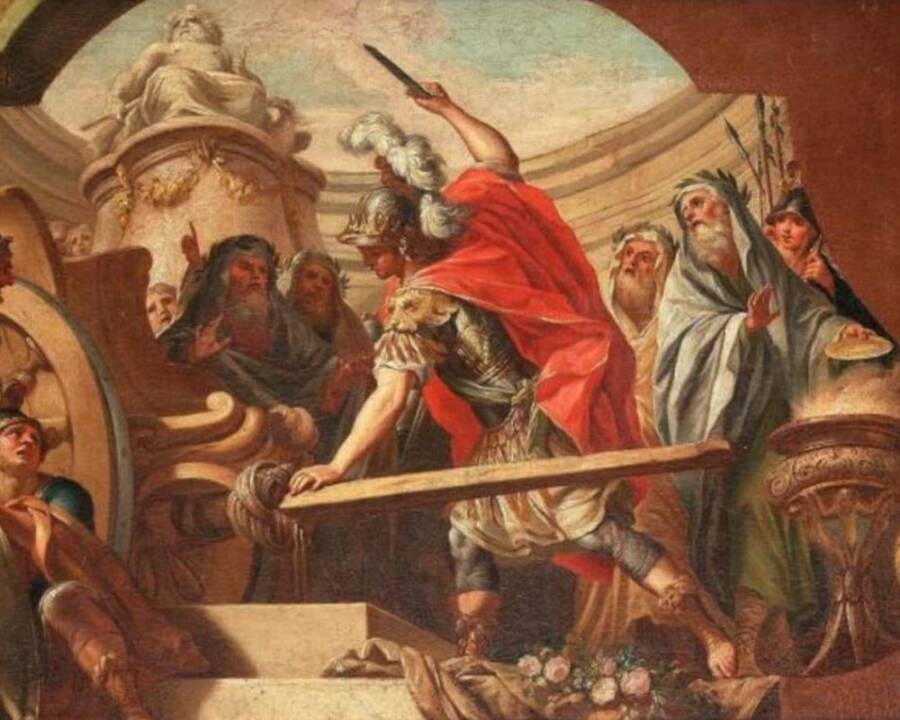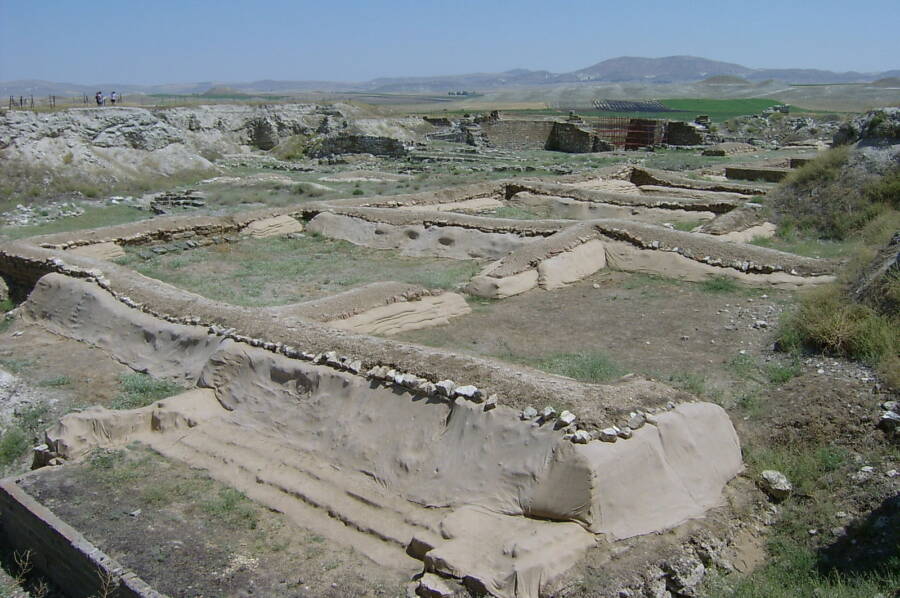In Greek mythology, the Gordian knot was an unsolvable puzzle that was tied by King Midas and later sliced in half by Alexander the Great, foretelling his imminent takeover of western Asia.

Public DomainA depiction of Alexander the Great cutting the Gordian knot by 18th-century Italian painter Fedele Fischetti.
The term “Gordian knot” is used today to describe a complicated problem that seemingly has no solution. But where did the phrase originate?
The story of the Gordian knot first appeared in Greek histories around 2,000 years ago. According to legend, Alexander the Great used his sword to slice through a length of rope that was allegedly impossible to untangle, foretelling his eventual takeover of much of Asia.
Some versions of the story claim that the knot was tied by the legendary King Midas himself, while others say Midas’ father, Gordias, created the unsolvable puzzle. Regardless, the myth has lasted through the millennia as a major part of Alexander the Great’s history.
But was the Gordian knot real? And did it actually have anything to do with the Macedonian leader’s rise to power?
What Was The Gordian Knot?
There are several versions of the Gordian knot’s origin, but they all start with the same man: Gordias (or Gordios), the father of King Midas. As the story goes, Gordias was a poor peasant living in Phrygia, which was located in modern-day Turkey.
He was plowing his fields one morning when he noticed an eagle sitting on the yoke of his wagon. It remained there all day, so Gordias decided to visit the Telmessians, who were ancient prophets, to determine if the bird’s presence was a sign.

Wikimedia CommonsThe ruins of Gordium, the ancient capital of Phrygia and alleged home of the fabled Gordian knot.
He first spoke with a Telmessian woman who ordered him to make a sacrifice to Zeus. Gordias did so — and then married the prophetess. This is where accounts begin to diverge. Some say that as Gordias rode into a city with his new bride in his wagon, the people living there declared him king, as an oracle had recently told them that their new leader would appear in an ox cart. This city became known as Gordium, or Gordion.
Other versions of the legend state that Gordias and his wife went on to have a son, Midas, and it was he who was declared king while driving his father’s wagon one day.
To thank Zeus for his new role as king, Midas — or Gordias, depending on the version of the story — dedicated the wagon in the Temple of Zeus and tied its yoke to its body with a complex knot. It was said that whoever managed to untie the knot would rule all of Asia.

Wikimedia CommonsBefore King Midas became known for turning everything he touched into gold, he allegedly tied the unsolvable Gordian knot.
Countless people tried to solve the Gordian knot, but nobody ever succeeded. Then, Alexander the Great came along.
Alexander The Great Cuts The Gordian Knot
Though the Gordian knot’s origin story is murky, Alexander the Great’s encounter with it was documented in multiple Greek histories.
In 333 B.C.E., Alexander the Great was three years into his campaign to expand his Macedonian empire. One day, his army marched into Gordium, the capital of Phrygia, and noticed a yoke attached to a wagon “which was made fast by a great number of thongs, closely tangled with one another and concealing their interlacings,” according to Roman historian Quintus Curtius Rufus’ History of Alexander.
Meanwhile, ancient Greek historian Arrian of Nicomedia wrote in The Anabasis of Alexander, “The cord was made of cornel bark, and neither end nor beginning to it could be seen.” Cornel wood is known for its density, and the Greeks often used it for weapons.

Metropolitan Museum of Art/Wikimedia CommonsA 1608 etching by Antonio Tempesta depicting Alexander the Great cutting the Gordian knot.
When Alexander learned that the Phrygians believed whoever untied the knot would become the ruler of Asia, he was “seized with an ardent desire” to try, according to Arrian. However, when he was unable to find the end of the rope to begin unraveling it, Alexander declared, “It makes no difference how they are loosed,” drew his sword, and sliced right through the knot.
Another version of the story says that the leader simply pulled out a lynchpin, loosening the knot and allowing him to untie it. Regardless, Alexander the Great became the first person to ever solve the puzzle, even if his method was unorthodox.
The story continues that a great storm arose that night, and Alexander and his men took it to mean that the gods were pleased. Of course, Alexander the Great did go on to conquer large swaths of western Asia before he died in 323 B.C.E. at the age of 32. But was it really because of the Gordian knot?
Did The Legendary Knot Actually Exist?
While there are at least five surviving ancient records of Alexander the Great and the Gordian knot, it’s unknown if the puzzle was real. The narratives surrounding it vary from teller to teller, giving the tale a mythical quality.
The legend of the Gordian knot spread over the centuries as an important part of Alexander the Great’s history, and over time, the term became part of the modern lexicon. That’s largely thanks to William Shakespeare.

Louvre Museum/Wikimedia CommonsThe legend of the Gordian knot and Alexander the Great’s rise to power continues to have an impact on language today.
In the opening scene of Shakespeare’s 1598 play Henry V, the Archbishop of Canterbury speaks of the titular king’s ability to handle complex politics, saying, “Turn him to any cause of policy, The Gordian knot of it he will unloose.”
As language evolved, the term “Gordian knot” came to be used to describe a complicated situation. And the phrase “cutting the Gordian knot” means finding an unexpected solution to an intricate problem.
So, while we may never know if the Gordian knot actually existed, the legend has taken on a life of its own — and made a very real impact on modern language.
After learning about the legend of the Gordian knot and Alexander the Great’s rise to power, find out more about Alexander the Great’s mother, Queen Olympias. Then, read about the rise and fall of another ancient wonder, the Colossus of Rhodes.





